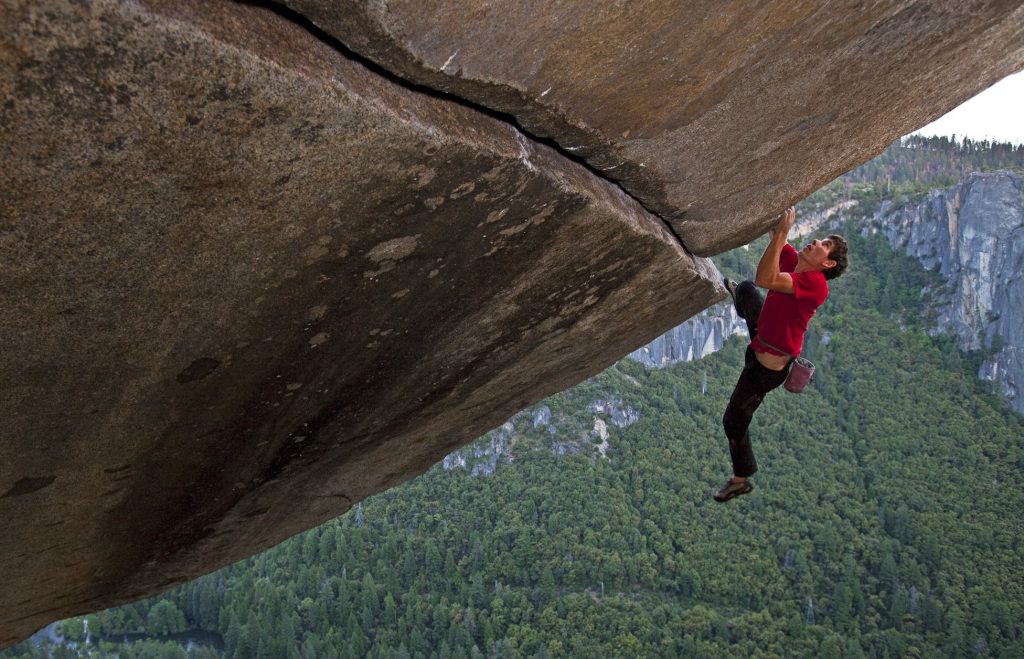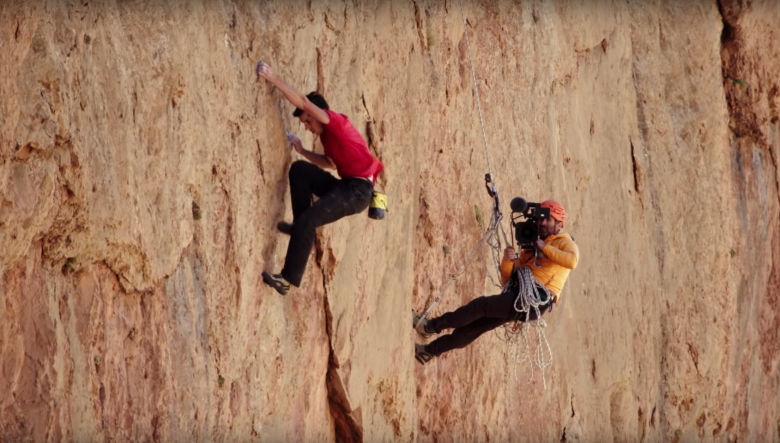The thrilling 2018 documentary Free Solo tells the story of American rock climber Alex Honnold and his attempt to climb El Capitan. Directed by partners Elizabeth Chai Vasarhelyi and Jimmy Chin who previously directed climbing documentary Meru (2015), Free Solo focuses on Alex Honnold in the midst of his training to climb El Capitan–a three thousand foot climb–without safety ropes. The film was first released at the Telluride Film Festival in August 2018, receiving high appraisal and many positive reviews, and later receiving even more buzz after it was nominated for Best Documentary Feature at the 2019 Academy Awards. Free Solo succeeds in capturing the true essence of Alex Honnold as an unorthodox climber with a magnetic presence while also utilizing impressive film techniques to capture his ascent unobtrusively. The film also can be commended for ethically addressing the various psychological issues surrounding the climb from multiple perspectives, including Honnold himself and friends and family.

Alex Honnold scales El Capitan without a rope.
The film opens with Honnold hanging onto the wall of El Capitan as an interview plays in the background. “One little mistake, one little slip and you fall and die?” asks the interviewer. “That’s correct, you seem to understand it,” replies Honnold. From the moment Alex Honnold is introduced on screen, the audience quickly gets a sense of exactly who Honnold is: a soft-spoken climber who clearly understands and accepts the danger of what he is about to do, able to maintain a highly focused and confident demeanor through every conversation about his climb. Honnold speaks about where his passion for climbing sparked – due to his father’s encouragement throughout his childhood to try the sport – and why he aspires to climb El Capitan. Traditional climbing is done with ropes, but Honnold explains he gets more enjoyment from free soloing (climbing with no rope or harness), because he gets more of a rush from it. Honnold’s muted sense of danger and calm approach to risk is then described through interviews from his friends and family. “Every time I climb with Alex it’s like cigarettes, I know it’s taking a risk and that I should quit, but there’s always going to be the urge to go back and climb with him” said Tommy Cadwell, a close friend and skilled climber. It isn’t until the end of the film that we see Honnold attempt a free solo ascent of El Capitan, an athletic achievement never before completed.
The face of El Capitan is a sheer face of granite that reaches over 3,000 feet off the ground, which created a bit of a challenge for filmmaker Jimmy Chin. The wall contains very few ledges large enough for cameramen to fit on and those that did exist were very difficult to reach, even with ropes. The solution to this issue was to enlist a small group of professional climbers who were also proficient filmmakers that could maneuver the wall with film equipment. The other large issue Chin faced was being able to film Honnold’s ascent without distracting or affecting his climb. This was a more difficult issue to overcome, but Chin used a few different solutions: setting up multiple long lens cameras on the ground that could not be seen by Honnold, placing camera men in strategic places along the route–specifically spots that didn’t contain difficult maneuvers so Honnold wouldn’t get nervous from their presence–and using remote-controlled cameras to capture these high-risk areas to alleviate any added pressure put on Honnold. The filmmakers additionally wanted to capture the audio of the climb, which they achieved by attaching a compact personal microphone, recording individual audio from Alex without transmitting (which would require attaching wires and a battery pack). Each technique and modification required intense focus and came with enormous pressure, every cameraman having to understand and accept the fact that they might end up recording Honnold falling to his death.
How They Filmed the First El Capitan Climb With No Ropes in “Free Solo” | Vanity Fair
A documentary like Free Solo introduces a number of ethical questions due to the high risk of death involved, which is why the filmmakers approached the project sensitively and were extremely flexible with capturing the climb. In one section of the film, Honnold believes he is ready to attempt the El Capitan climb, so the crew sets up all their cameras. Thirty minutes in, Honnold loses focus and decides to bail, not attempting again for three more months. Honnold’s ascent also raised ethical concerns among his close friends and family, who were all very reluctant to let him attempt the climb. ”I think he feels the most alive when he free solos so how can I take that away from him,” said Dierdre Honnold, in regards to her son. As Honnold’s friends and family express their reluctance for him to climb, they also accept the fact that the decision resides with Honnold himself. Honnold displays a strong and almost spiritual desire to free solo the three thousand foot wall, but was uneasy about allowing his attempt to be filmed: “The idea of me falling off alone is okay, but the idea of falling in front of my friends is messed up,” he says.

Alex Honnold and cinematographer
Free Solo is a thrilling documentary that provides an entertaining look into the mind of Alex Honnold as he attempts an incredible feat. The film succeeds in finding creative and ethical solutions to filming such a dangerous event and is an exemplary look at film making and film technique. Free Solo was able to approach a controversial project in a respectful and empathetic manner, displaying ethical decision making alongside incredible technique to tell the amazing – and true – story of an astonishing human achievement.


Trackbacks/Pingbacks